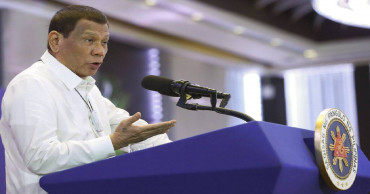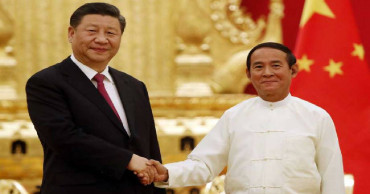South China Sea
China's Premier Li talks trade in Vietnam despite differences over South China Sea
China agreed Sunday to assist Vietnam on cross-border railway development and take steps to expand agricultural imports from its smaller neighbor, Vietnam’s official media said.
Premier Li Qiang, on an official visit to Vietnam, pledged that China would further open its market to high-quality fruits, seafood and other Vietnamese products, a state media report said.
China is Vietnam’s largest trading partner and second-largest export market after the U.S. Trade between the two countries reached $172 billion in 2023. Vietnam’s top leader, To Lam, signaled the importance of the relationship when he made China his first overseas visit after assuming his post last year.
Li came to Vietnam from neighboring Laos, where he had pushed back against calls at a meeting of Southeast Asian leaders to respect international law in territorial disputes in the South China Sea.
China looking forward to work closely with Bangladesh: Envoy
Vietnamese Prime Minister Pham Minh Chinh told Li that both sides should respect each other’s legitimate rights and interests, resolve disputes through peaceful means and properly address issues related to fishers and their vessels, the state media report said.
Vietnam condemned China two weeks ago for what it described as an assault by Chinese law enforcement personnel that injured several Vietnamese fishers near the Paracel Islands in the South China Sea.
The islands have been under the de facto control of China since 1974, when Beijing seized them from Vietnam in a brief but violent naval conflict.
U.S. Secretary of State Antony Blinken told the Southeast Asian leaders gathered in Laos last week that the U.S. is concerned about China’s “increasingly dangerous and unlawful” activities in the South China Sea, which Beijing claims virtually in its entirety.
In their talks on Sunday, Chinh and Li agreed to deepen exchange and cooperation in diplomacy, national defense and public security, the state media report said.
They also witnessed the exchange of 10 cooperation agreements, including the establishment of a working group to develop cross-border economic cooperation zones and the implementation of QR-code, cross-border payment services.
The railway agreements covered a technical plan and feasibility studies to improve train connectivity between Vietnam and China.
On trade, Chinh asked for greater access for a range of products including tropical fruits, meat products, farm-raised spiny lobster and plant-based traditional medicines.
Li said that China stands ready to resolve trade issues and work with Vietnam on quarantine and customs procedures, according to the Vietnamese report.
1 year ago
US, Filipino forces show power in drills amid China tensions
Thousands of American and Filipino forces pummeled a ship with a barrage of high-precision rockets, airstrikes and artillery fire in their largest war drills on Wednesday in Philippine waters facing the disputed South China Sea that would likely antagonize China.
President Ferdinand Marcos Jr. watched the American show of firepower from an observation tower in the coastal town of San Antonio in northwestern Zambales province — the latest indication of his strong backing of the Philippines' treaty alliance with the U.S.
Marcos has ordered his military to shift its focus to external defense from decades-long anti-insurgency battles as China’s increasingly aggressive actions in the South China Sea become a top concern. The shift in the Philippine defense focus falls in sync with the Biden administration’s aim of reinforcing an arc of alliances in the Indo-Pacific region to better counter China.
Also Read: US sails warship through Taiwan Strait after China's drills
China has angered the Philippines by repeatedly harassing its navy and coast guard patrols and chasing away fishermen in the waters close to Philippine shores but which Beijing claims as its own. The Philippines has filed more than 200 diplomatic protests against China since last year, including at least 77 since Marcos took office in June.
Sitting beside U.S. Ambassador MaryKay Carlson and his top defense and security advisers, Marcos used a pair of binoculars, smiling and nodding, as rockets streaked into the blue sky from the U.S. High Mobility Artillery Rocket System, or HIMARS, a multiple rocket and missile launcher mounted on a truck that has become a crucial weapon for Ukrainian troops battling Russian invasion forces.
The coastal clearing in front of Marcos resembled a smoke-shrouded war zone, which thudded with artillery fire as AH-64 Apache attack helicopters flew overhead.
Also Read: US, Philippines hold largest war drills near disputed waters
“This training increased the exercise’s realism and complexity, a key priority shared between the Armed Forces of the Philippines and the U.S. military,” Lt. Gen. William Jurney, commander of U.S. Marine Corps Forces, Pacific, said.
“Together we are strengthening our capabilities in full-spectrum military operations across all domains,” said Jurney, the U.S. director for the annual joint exercises called Balikatan, Tagalog for ”shoulder-to-shoulder."
About 12,200 U.S military personnel, 5,400 Filipino forces and 111 Australian counterparts were taking part in the exercises, the largest since Balikatan started three decades ago. The drills have showcased U.S. warships, fighter jets as well as Patriot missiles, HIMARS and anti-tank Javelins, according to U.S. and Philippine military officials.
The ship targeted by the allied forces was a decommissioned Philippine navy warship, which was towed about 18 to 22 kilometers (11 to 14 miles) out to sea.
Smaller floating targets, including empty drums tied together, were also used as targets to simulate a battle scene where a U.S. Marine Corps command and control hub enabled scattered allied forces to identify and locate enemy targets then deliver precision rocket and missile fire.
Philippine military officials said the maneuvers would bolster the country’s coastal defense and disaster-response capabilities and were not aimed at any country. China has opposed military drills involving U.S. forces in the region in the past as well as increasing U.S. military deployments, which it warned would rachet up tensions and hamper regional stability and peace.
Washington and Beijing have been on a collision course over China’s increasingly assertive actions to defend its vast territorial claims in the South China Sea and Beijing’s goal of annexing Taiwan, by force if necessary.
In February, Marcos approved a wider U.S. military presence in the Philippines by allowing rotating batches of American forces to stay in four more Philippine military camps. That was a sharp turnaround from his predecessor Rodrigo Duterte, who feared that a larger American military footprint could antagonize Beijing.
China strongly opposed the move, which would allow U.S. forces to establish staging grounds and surveillance posts in the northern Philippines across the sea from Taiwan and in western Philippine provinces facing the South China Sea, which Beijing claims virtually in its entirety.
China has warned that a deepening security alliance between Washington and Manila and their ongoing military drills should not harm its security and territorial interests or interfere in the territorial disputes.
The Chinese Foreign Ministry has said that such military cooperation “should not target any third party and should be conducive to regional peace and stability.”
2 years ago
Philippines eyes South China Sea patrols with US, Australia
The Philippines is in talks with the United States as well as Australia on future joint patrols in the South China Sea, where China's increasingly aggressive actions in the disputed waters are causing concern, top defense officials in the three nations said Wednesday.
U.S. Defense Secretary Lloyd Austin called his Philippine counterpart, Carlito Galvez Jr., to reiterate Washington’s support and commitment to help defend its oldest treaty ally in Asia after a Chinese coast guard aimed a military-grade laser at a Philippine patrol vessel near a disputed shoal.
The Feb. 6 incident off Second Thomas Shoal briefly blinded some of the Filipino crew and prompted Manila to file a strongly worded diplomatic protest. President Ferdinand Marcos Jr. also summoned China’s ambassador to express his concern.
Also Read: US renews warning it’ll defend Philippines after China spat
“The two leaders discussed proposals to deepen operational cooperation and enhance the United States and the Philippines’ shared security, including the recent decision to resume combined maritime activities in the South China Sea,” according to details of the phone conversation provided by Pentagon press secretary Brig. Gen. Pat Ryder.
During Austin's visit to Manila this month, Galvez and U.S. officials had said the allies agreed to carry out joint patrols.
Separately, Galvez and visiting Australian Defense Minister Richard Marles said in a news conference on Wednesday that they were looking at Australian and Philippine forces possibly carrying out their joint patrols in the busy waterway.
Also Read: US, Philippines agree on larger American military presence
As countries asserting the rule of law, including the 1982 U.N. Convention on the Law of the Sea, in the South China Sea, where a bulk of Australia’s trade traverses, “we did talk today about the possibility of exploring joint patrols,” Marles said, without elaborating.
Australian and Philippine forces have undertaken joint patrols off the southern Philippines in the past to counter terrorist threats, Galvez said, and added, “We can do it again."
Aside from the United States, Australia is the only other country that struck a defense agreement with the Philippines for joint combat exercises in the country. The Philippine Constitution prohibits the permanent basing of foreign troops and their involvement in local combat.
Austin announced after meeting Marcos on Feb. 2 that the Philippines had approved an expanded U.S. military presence by allowing rotating batches of U.S. forces to stay in four more Philippine military camps, in addition to five others.
It was the latest move by the Biden administration to strengthen an arc of military alliances in the Indo-Pacific to better counter China, including in any future confrontation over Taiwan.
Austin reaffirmed in his talk with Galvez on Wednesday the U.S. Defense Department’s “commitment to bolstering the Philippines’ defense capabilities and capacity to resist coercion as the allies develop a security-sector assistance roadmap.” No details of the mutual security plan were immediately provided.
China opposes military activities involving the U.S. and its allies, especially in the South China Sea, and has warned Washington not to meddle in what it says is a purely Asian dispute.
Chinese forces have protested the presence of U.S. Navy ships and fighter jets that have been enforcing freedom of movement in the contested waters. The U.S. military insists it would exercise its rights under international law to sail and fly in international waters.
In Jakarta, visiting Chinese Foreign Minister Qin Gang said on Wednesday that China would work with the Association of Southeast Asian Nations, which is currently led by Indonesia, to hasten negotiations on a proposed nonaggression pact, which is designed to avoid armed confrontations in the South China Sea.
“China and Indonesia will work with other ASEAN countries to … accelerate consultations on a code of conduct in the South China Sea, and jointly maintain the peace and stability in the South China Sea fully and effectively.” Gang said in an online press conference.
The highly secretive talks between China and the 10-nation ASEAN, whose four members are locked in territorial conflicts with Beijing over the strategic waterway, have faced years of delay, including during the height of the coronavirus pandemic.
China and the regional bloc have agreed to speed up the negotiations this year but it's unclear how they can overcome key differences, including which areas should be covered by the pact and whether the agreement should be legally binding.
2 years ago
Chinese cargo spacecraft docks with orbital station
An automated spacecraft docked with China’s new space station Sunday carrying fuel and supplies for its future crew, the Chinese space agency announced.
Tianzhou-2 spacecraft reached the Tianhe station eight hours after blasting off from Hainan, an island in the South China Sea, China Manned Space said. It carried space suits, living supplies and equipment and fuel for the station.
Read:China’s Mars rover touches ground on red planet
Tianhe, or Heavenly Harmony, is third and largest orbital station launched by China’s increasingly ambition space program.
The station’s core module was launched April 29. The space agency plans a total of 11 launches through the end of next year to deliver two more modules for the 70-ton station, supplies and a three-member crew.
China was criticized for allowing part of the rocket that launched the Tianhe to fall back to Earth uncontrolled. There was no indication about what would happen to the rocket from Saturday’s launch.
Read:China delays supply mission to newly launched space station
Beijing doesn’t participate in the International Space Station, largely due to U.S. objections. Washington is wary of the Chinese program’s secrecy and its military connections.
4 years ago
China, Philippines swap protests over Manila-occupied island
The Philippines has demanded that China withdraw its ships and fishing vessels from the vicinity of a Philippine-occupied island in the South China Sea, where the Chinese military has asserted its sovereignty and vowed to “unswervingly safeguard” the disputed territory.
The exchange of protests by the Asian neighbors over the island, internationally called Thitu, is the latest flareup in a long simmering territorial feud in the strategic waterway that has escalated in the last two months.
The Department of Foreign Affairs in Manila said Saturday it has filed a diplomatic protest against “the incessant deployment, prolonged presence and illegal activities of Chinese maritime assets and fishing vessels in the vicinity of the Pag-asa islands.” It used the Philippine name for Thitu, which China calls Zhongye Dao.
READ: Philippines weighs extending lockdown as COVID cases top 1M
The department demanded that China withdraw its vessels from near the island, which it said “is an integral part of the Philippines over which it has sovereignty and jurisdiction.”
The 37.2-hectare (92-acre) island is the largest of nine mostly islets, reefs and shoals occupied by Philippine forces in the disputed waters. The Manila government lists Thitu and outlying outcrops as part of a town in western Palawan province.
Aside from Filipino troops and police, a small fishing community can be found on Thitu. The government has constructed a beach ramp to allow the docking of navy and cargo ships and unloading of construction materials and heavy equipment for new projects, including the repair and lengthening of a seawater-eroded airstrip, an ice plant for fishermen and more military barracks.
Chinese officials have not protested as loudly as before the Philippine constructions amid cozier ties between Beijing and Manila under Philippine President Rodrigo Duterte. But on Thursday, Chinese Defense Ministry spokesman Tang Kefei said China was “resolutely opposed” to any Philippine development on Thitu.
“China’s military will unswervingly safeguard national territory, sovereignty and maritime rights, while resolutely maintaining peace and stability in the South China Sea,” Tang said, without elaborating at a monthly briefing.
The escalating feud between Manila and Beijing started after more than 200 Chinese vessels suspected by Philippine authorities to be operated by government militias were spotted in early March at Whitsun Reef. The Philippine defense chief and foreign secretary demanded the vessels leave, and Filipino officials later deployed navy and coast guard vessels to the area. China said it owns the reef and the Chinese vessels were sheltering there from rough seas.
The Philippines has issued dozens of diplomatic protests to China since then over the disputes.
READ: Philippines launches virus vaccinations amid supply problems
Foreign Secretary Teodoro Locsin Jr. apologized early this month after tweeting an obscene phrase demanding China get out of Philippine-claimed territory in the South China Sea in an outburst that annoyed Duterte.
“Just because we have a conflict with China does not mean to say that we have to be rude and disrespectful,” Duterte said. “We have many things to thank China for the help in the past and its assistance now.”
4 years ago
China warns off trespassing US warship in South China Sea
A US warship trespassing into China's territorial waters has been warned off, a military spokesperson confirmed, vowing that the Chinese military would continue its resolute efforts to safeguard national sovereignty and maintain peace and stability in the South China Sea.
5 years ago
China says U.S. accusation on South China Sea ‘completely unjustified’
A spokesperson of the Chinese embassy in the United States on Monday said the accusation against China on the South China Sea issue is ‘completely unjustified’.
The statement that the U.S. Department of State issued earlier in the day disregards the efforts of China and ASEAN countries for peace and stability in the South China Sea.
However, it deliberately distorts the facts and international law including the United Nations Convention on the Law of the Sea (UNCLOS), exaggerates the situation in the region and attempts to sow discord between China and other littoral countries, the spokesperson said.
"China's position on the South China Sea issue has been consistent and clear-cut," said the spokesperson.
The spokesperson noted that the situation of the South China Sea has remained peaceful and stable and is still improving.
China and other littoral countries have maintained dialogue and communication through consultation mechanisms on maritime affairs, and worked to promote cooperation over the South China Sea.
Within the framework of fully and effectively implementing the Declaration on the Conduct of Parties in the South China Sea, China and ASEAN countries are advancing the consultation on a Code of Conduct in the South China Sea and are making visible progress, the spokesperson said.
5 years ago
Recent developments surrounding the South China Sea
A look at recent developments in the South China Sea, where China is pitted against smaller neighbors in multiple territorial disputes over islands, coral reefs and lagoons. The waters are a major shipping route for global commerce and are rich in fish and possible oil and gas reserves.
5 years ago
Recent developments surrounding the South China Sea
A look at recent developments in the South China Sea, where China is pitted against smaller neighbors in multiple territorial disputes over islands, coral reefs and lagoons. The waters are a major shipping route for global commerce and are rich in fish and possible oil and gas reserves.
5 years ago




.jpg)

.jpg)







